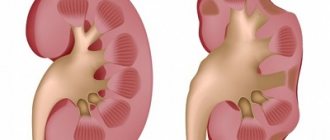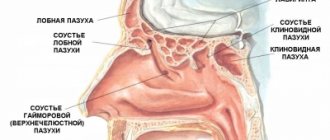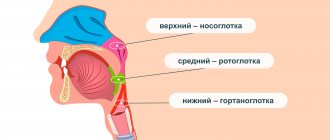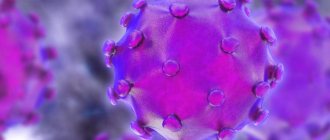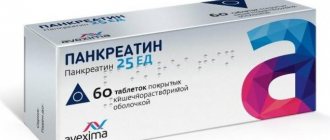General information
Nephritis is a group of kidney diseases of an inflammatory nature. There are two main forms in children: hereditary and acquired.
The inflammatory process usually occurs in both kidneys of the child, spreading to the pyelocaliceal system, renal glomeruli and tubules. This disease can appear even in newborns; in medicine there is currently no consensus on what the mechanism of the onset and development of the disease is. Acute tubulointerstitial nephritis is usually provoked in children by a hereditary predisposition, accompanied by infection and allergies. Source: N.I. Khlebovets Tubulointerstitial nephritis in children // Journal of Grodno State University, 2014, No. 1, pp. 94-97
Diagnosis of acute pyelonephritis
An experienced doctor will suspect a developed disease only based on the patient’s complaints. To confirm the diagnosis, the following measures are required:
- Collection of anamnestic data. The doctor asks the patient about what preceded the onset of symptoms, when pain and other discomfort are most common. The presence of chronic pathologies of the urinary system in the patient also helps to determine the diagnosis.
- Examination of the patient. An acute course of the infectious process is indicated by high fever, chills, and increased sweating.
- Studying the results of laboratory, including biochemical studies.
- Study of instrumental research data.
The patient is required to undergo general clinical tests, Zimnitsky's test, and urine examination using the Nechiporenko method.
In a laboratory setting, urine is cultured into culture media. The shape, size, and number of formed colonies are used to judge the type of infectious agents, the severity of the inflammatory process, as well as the sensitivity of pathogenic bacteria to antibiotics, which are most often used in the complex therapy of acute pyelonephritis.
The information content and reliability of laboratory test data directly depends on the correct collection of urine. Be sure to pre-wash the genitals and dry them. The collection of biological material is carried out in a special sterile compact container with a tightly screwed lid.
The presence of an infectious kidney lesion is indicated by a high level of leukocytes and the presence of a large number of microorganisms. The erythrocyte sedimentation rate in blood tests is also increased. Indirect confirmation of the development of acute pyelonephritis is alkalinization of urine, increased quantitative content of proteins and glucose.
The main causes of illness in childhood:
- various maternal illnesses during pregnancy;
- diabetes;
- oncology;
- autoimmune processes;
- myeloma;
- vasculitis;
- acute infections;
- thrombosis;
- damage to the body by salts of heavy metals;
- self-medication with medications without specialist supervision (the use of antibiotics without appropriate prescription is especially dangerous);
- reactions to vaccines;
- hypothermia;
- tuberculosis.
Risk factors
Doctors identify a number of factors that can predispose to kidney damage by acute pyelonephritis. The likelihood of its development increases in the presence of the following pathological conditions:
- congenital or acquired anomalies of the structure of the kidneys, urinary ducts, urethra, bladder;
- immunodeficiency conditions, including HIV;
- urolithiasis;
- diabetes mellitus, in which pathogens grow and multiply especially intensively due to the presence of glucose;
- previous traumatic injuries of the spinal cord, organs located in the abdominal cavity;
- any inflammatory chronic disease in which infectious foci form;
- prostatic hyperplasia, prostatitis.
Elderly people are predisposed to acute pyelonephritis, including due to the presence of a number of chronic diseases of internal organs at this age. Also, its development can be triggered by surgery or medical manipulation.
Symptoms of the disease
Symptoms are usually the same, regardless of the cause of kidney damage, and are also similar for children of any age - from newborns to teenagers:
- swelling;
- decreased appetite;
- general weakness;
- feeling of dry mouth;
- chills;
- skin redness;
- dry skin, hair, nails;
- headache;
- pain in the lumbar area;
- convulsions;
- small volume of daily urine;
- bloating;
- vomiting and other gastrointestinal disorders.
If the disease lasts for a long time, then the death of a large number of renal glomeruli occurs. As a result, kidney failure occurs.
The chronic form of the disease is characterized by:
- intense sweating, increasing at night;
- decreased appetite;
- yellow skin tone;
- frequent urge to urinate;
- pain during urination;
- cloudy urine.
Clinical manifestations of pyelonephritis in pregnant women
During pregnancy, the female body is exposed to high stress. Due to the constantly growing uterus, the functioning of internal organs may be disrupted. In combination with hormonal fluctuations and weakened immune defenses, this often causes the development of acute pyelonephritis, especially in the second and third trimesters.
The main cause of infectious and inflammatory damage to the kidneys in pregnant women is strangulation of the ureters by the growing uterus. As a result of disruption of the full outflow of urine, favorable conditions are created for an increase in the population of pathogenic microorganisms. Often, pyelonephritis develops against the background of cystitis, an acute or chronic inflammatory lesion of the mucous layer of the bladder.
Classification of jades
| Type of jade | Peculiarities |
| Pyelonephritis | Inflammatory process in the pyelocaliceal system. It is bacterial in nature, provoked by E. coli, staphylococcus and a number of other pathogens. |
| Glomerulonephritis | The kidney glomeruli are negatively affected. It can be of three forms: acute, subacute and chronic. Characterized by swelling, blood in the urine, increased blood pressure. Source: Lechon FC, Espi MT, Abal RP, Peiro JLE Acute glomerulonephritis associated with pneumonia: review of three cases. Ped. Nephrol. 2010; 25: 161-164 |
| Interstitial nephritis in children | Damage to renal tissues and tubules. The causes are viruses, uncontrolled use of diuretics and antibiotics. |
| Tubulointerstitial | Damage to the interstitial tissue of the kidneys and tubules, aseptic inflammation of the tissues. The process involves the lymph flow and blood vessels. |
| Lupus | The cause is lupus erythematosus, which provokes inflammation not only in the kidneys. Source: G.A. Makovetskaya, L.I. Mazur, V.N. Barinov, E.A. Barannikova, E.M. Romadanova, P.V. Morinets Lupus nephritis in children: manifestation, diagnosis, treatment // Russian Bulletin of Perinatology and Pediatrics, 2022, No. 62(4), pp. 185-186 |
| Acquired diffuse | Streptococcal infection in a newborn, damage to kidney tissue. |
| Ray | It is provoked by ionizing radiation, as a result of which the function of the renal tubules is impaired. In the chronic form, renal failure or arterial hypertension develops. |
| Hereditary | At the beginning of development, symptoms are almost completely absent. As the disease progresses, hearing and vision may decrease, unusual fatigue may appear, and the skin often turns pale. |
Instrumental studies
Instrumental diagnostics are necessary not only to detect kidney damage. It is carried out to determine the localization of the pathological process, the degree of its severity, as well as factors predisposing to the development of acute pyelonephritis. The most informative results are the following instrumental studies:
- Ultrasound. Using ultrasound, it is possible to accurately assess the density of paired organs, their shape and size. Acute inflammation is indicated by abnormal values of these diagnostic criteria and an uneven decrease in echogenicity.
- CT. Computed tomography allows you to obtain an x-ray picture in the form of thin layer-by-layer sections.
- Excretory urography. A diagnostic technique aimed at examining all organs of the urinary system. They are clearly visualized on photographs due to the preliminary intravenous administration of a contrast agent.
- Cystography. The study helps to identify vesicoureteral reflux, which provokes the reverse reflux of urine. It consists of an X-ray examination of the bladder, previously filled with a contrast agent.
Differential diagnosis is also carried out to exclude pathological conditions that manifest similar symptoms, such as renal failure.
Methods of treating the disease
Important! Treatment should only be carried out by a doctor who strictly controls the course of therapy. It is prohibited to try to cure a child on your own, use folk remedies, or rely on the experience of other parents.
After making a diagnosis, the doctor prescribes a special diet for the child. The child must be kept in bed and not be exposed to stress or stress.
Drug therapy is carried out using vitamin complexes and antibiotics. It can be adjusted if the expected effect is not achieved. The duration of drug treatment is usually long - up to one and a half months.
Sometimes (in the presence of toxins in the blood plasma) plasmapheresis and hemosorption (blood purification) are performed.
Any therapy requires the participation of a specialist and regular tests to monitor the progress of treatment. When the main course is completed, children are often sent to sanatoriums and physiotherapy is recommended.
Methods for preventing childhood nephritis
Parents should be aware that self-prescription of preventive medications is unacceptable. Even after an examination, only a doctor should do this.
As part of prevention, it is important to monitor the child’s lifestyle, promptly identify alarming symptoms, and conduct medical examinations in this profile. For children at risk, physical therapy, hardening, moderate physical activity, and adherence to a certain diet are recommended (consult a doctor to determine this).
Advantages of SM-Clinic
Our medical center employs some of the best specialists in the Northern capital: pediatric nephrologists, urologists, pediatricians.
“SM-Clinic” has modern equipment, thanks to which diseases are diagnosed quickly and accurately. This makes it possible to return children to normal life in a short time. We have no queues, the approach to each child is always individual and delicate. If inpatient observation is required, comfortable rooms are provided.
Sources:
- N.I. Khlebovets. Tubulointerstitial nephritis in children // Journal of Grodno State University, 2014, No. 1, pp. 94-97.
- Lechon FC, Espi MT, Abal RP, Peiro JLE. Acute glomerulonephritis associated with pneumonia: review of three cases. Ped. Nephrol. 2010; 25: 161-164.
- G.A. Makovetskaya, L.I. Mazur, V.N. Barinov, E.A. Barannikova, E.M. Romadanova, P.V. Morinets. Lupus nephritis in children: manifestation, diagnosis, treatment // Russian Bulletin of Perinatology and Pediatrics, 2022, No. 62(4), pp. 185-186.
Lavrishcheva Yulia Vladimirovna Clinic
Author of the article
Lavrishcheva Yulia Vladimirovna
Doctor of the first qualification category
Specialty: nephrologist
Experience: 14 years
The information in this article is provided for reference purposes and does not replace advice from a qualified professional. Don't self-medicate! At the first signs of illness, you should consult a doctor.
Prices
| Name of service (price list incomplete) | Price |
| Appointment (examination, consultation) with a medical specialist, primary, therapeutic and diagnostic, outpatient (other specialties) | 1750 rub. |
| Consultation (interpretation) with analyzes from third parties | 2250 rub. |
| Prescription of treatment regimen (for up to 1 month) | 1800 rub. |
| Prescription of treatment regimen (for a period of 1 month) | 2700 rub. |
| Consultation with a candidate of medical sciences | 2500 rub. |
| Kidney ultrasound | 1700 rub. |
| Ultrasound scanning of kidney vessels | 2500 rub. |
